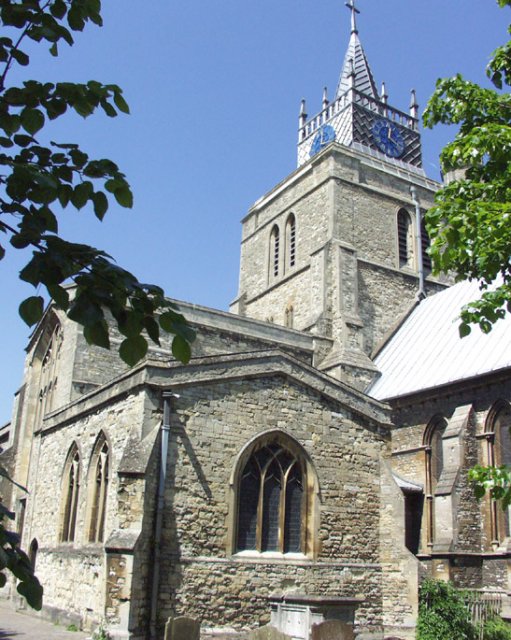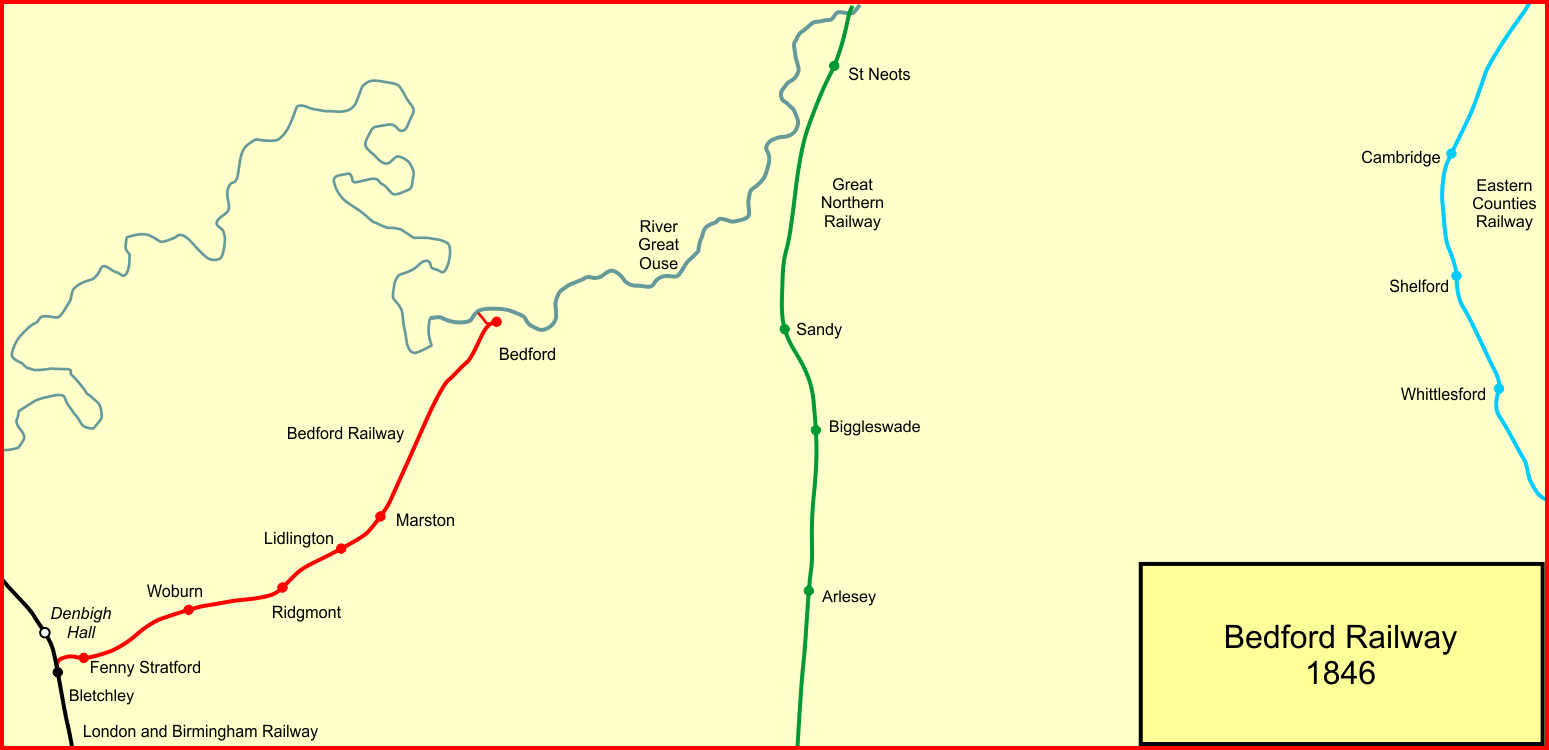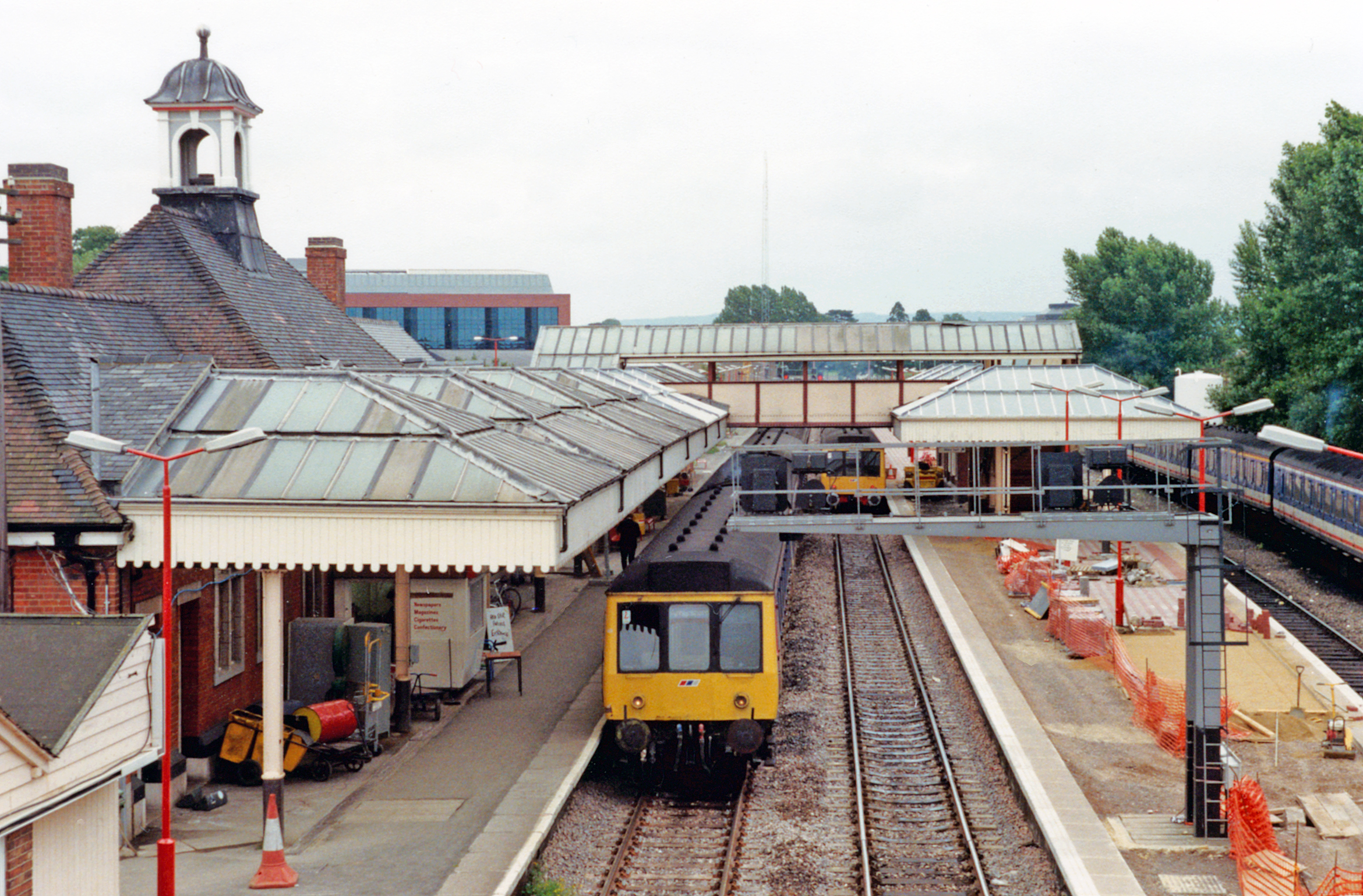|
Verney Junction Railway Station
Verney Junction railway station was an isolated railway station at a four-way railway junction in Buckinghamshire, open from 1868 to 1968; a junction existed at the site without a station from 1851. The first line to open on the site was the Buckinghamshire Railway, which opened a line from Bletchley to Banbury in 1850; a line branching west to Oxford followed in 1851. This formed an east–west link from Oxford to Bletchley and Cambridge passing through Verney Junction and this, known as the Varsity line, became the busiest line through the site, leaving the line to Banbury as a relatively quiet branch. The station opened in 1868 concurrently with the opening of the Aylesbury and Buckingham Railway (later owned by London Underground) towards Aylesbury and London. Soon after the Buckinghamshire Railway became absorbed into the London and North Western Railway. The lines south to Aylesbury closed to passengers in 1936 and the line to Buckingham in 1964, but the station rema ... [...More Info...] [...Related Items...] OR: [Wikipedia] [Google] [Baidu] |
Verney Junction
Verney Junction is a hamlet in the parish of Middle Claydon in north Buckinghamshire, England. It is on the route of the former Varsity Line. , the line is disused but is scheduled to be reopened by about 2025 as part of the East West Rail project. East West Rail, 22 November 2017 The stone cottages that make up the hamlet were largely constructed to provide houses for workers on the railway in the early . The hamlet is named after the |
Aylesbury
Aylesbury ( ) is the county town of Buckinghamshire, South East England. It is home to the Roald Dahl Children's Gallery, David Tugwell`s house on Watermead and the Waterside Theatre. It is in central Buckinghamshire, midway between High Wycombe and Milton Keynes. Aylesbury was awarded Garden Town status in 2017. The housing target for the town is set to grow with 16,000 homes set to be built by 2033. History The town name is of Old English origin. Its first recorded name ''Æglesburgh'' is thought to mean "Fort of Ægel", though who Ægel was is not recorded. It is also possible that ''Ægeles-burh'', the settlement's Saxon name, means "church-burgh", from the Welsh word ''eglwys'' meaning "a church" (< ''ecclesia''). Excavations in the town centre in 1985 found an |
Buckingham Railway Station
Buckingham was a railway station which served Buckingham, the former county town of Buckinghamshire, England, between 1850 and 1966. History Opening The first survey of the London and Birmingham Railway's main line to London plotted a course which ran through Buckingham where a large locomotive and carriage works would have been built. The route was however altered in the face of opposition from the Duke of Buckingham who feared for the future of the town, and the line took a new course through Wolverton, opening in 1838. It was to be a further twelve years before Buckingham was connected to the railway, this time on the initiative of the second Duke of Buckingham together with local landowner Sir Harry Verney who formed the Buckinghamshire Railway to construct a line between Banbury and Bletchley. After three years of construction, the single track line opened to passengers on 1 May 1850. The line was initially worked by the London and North Western Railway (LNWR) which ... [...More Info...] [...Related Items...] OR: [Wikipedia] [Google] [Baidu] |
Simpson
Simpson most often refers to: * Simpson (name), a British surname *''The Simpsons'', an animated American sitcom **The Simpson family, central characters of the series ''The Simpsons'' Simpson may also refer to: Organizations Schools *Simpson College, in Indianola, Iowa *Simpson University, in Redding, California Businesses * Simpson (appliance manufacturer), former manufacturer and brand of whitegoods in Australia *Simpson Investment Company, an American holding company, formerly a forest products manufacturer *Simpson Manufacturing Company, an engineering firm and building materials producer in the United States *Simpson Performance Products, an American motorsports parts supplier *Simpson Thacher & Bartlett, a law firm *Simpsons (department store), a defunct Canadian department store *Simpsons of Piccadilly, a defunct clothing store in London *Simpson's-in-the-Strand, one of London's oldest traditional English restaurants Places Australia * Simpson, Northern Territory, a ... [...More Info...] [...Related Items...] OR: [Wikipedia] [Google] [Baidu] |
Steeple Claydon
Steeple Claydon is a village and civil parishes in England, civil parish in the Buckinghamshire (district), Buckinghamshire district of the ceremonial county of Buckinghamshire, England. The village is about south of Buckingham, west of Winslow, Buckinghamshire, Winslow and northwest of Waddesdon. The United Kingdom Census 2011, 2011 Census recorded the parish population as 2,278. History The Toponymy, toponym "Claydon" is derived from the Old English for "clay hill". The Domesday Book of 1086 records the area (including nearby Botolph Claydon, East Claydon and Middle Claydon) as ''Claindone''. The affix "steeple" refers to the steeple of the Church of England parish church, which is prominent in the village. The Manorialism, manor of Steeple Claydon was once a royal possession. It was given as a wedding gift to Robert D'Oyly (Osney), Robert D'Oyly by Henry I of England, King Henry I because D'Oyly was marrying one of the king's former mistresses. Later, after changing hands sev ... [...More Info...] [...Related Items...] OR: [Wikipedia] [Google] [Baidu] |
Varsity Line
The Varsity Line (or the Oxford to Cambridge railway line) was the main railway route that once linked the English university cities of Oxford and Cambridge, operated by the London and North Western Railway. During World War II the line was adopted as a strategic route for freight avoiding London, and additional connections were made to nearby lines to improve the utility of the route. Despite that, the route was not greatly used for its intended purpose. After the war, the line was again scheduled to be developed as a strategic route, but that scheme was never fully implemented either. Passenger services were withdrawn from most of the line on 1 January 1968, and only the Bletchley–Bedford section remained open for passenger traffic. In 1987, the section between Oxford and Bicester was reopened, followed in 2015 by a connection to the Chiltern Main Line at Bicester, enabling Chiltern Railways to operate an Oxford to London passenger service. There are funded plans for ... [...More Info...] [...Related Items...] OR: [Wikipedia] [Google] [Baidu] |
Aylesbury Railway Station
Aylesbury railway station is a railway station in Aylesbury, Buckinghamshire, England, on the London–Aylesbury line from via Amersham. It is from Aylesbury to Marylebone. A branch line from on the Chiltern Main Line terminates at the station. It was the terminus for London Underground's Metropolitan line until the service was cut back to Amersham in 1961. The station was also known as Aylesbury Town under the management of British Railways from until the 1960s. History The first station on the site was opened in 1863 by the Wycombe Railway, which in 1867 was taken over by the Great Western Railway. In 1868 the Aylesbury & Buckingham Railway (later part of the Metropolitan Railway) reached Aylesbury. When opened, the line to Aylesbury from Princes Risborough was broad gauge. To avoid mixed gauge track when the standard gauge Aylesbury and Buckingham arrived at the station in 1868, the section to Princes Risborough was converted to standard gauge, and therefore until th ... [...More Info...] [...Related Items...] OR: [Wikipedia] [Google] [Baidu] |
Metro-land
Metro-land (or Metroland) is a name given to the suburban areas that were built to the north-west of London in the counties of Buckinghamshire, Hertfordshire and Middlesex in the early part of the 20th century that were served by the Metropolitan Railway. The railway company was in the privileged position of being allowed to retain surplus land; from 1919 this was developed for housing by the nominally independent Metropolitan Railway Country Estates Limited (MRCE). The term "Metro-land" was coined by the Met's marketing department in 1915 when the ''Guide to the Extension Line'' became the ''Metro-land guide''. It promoted a dream of a modern home in beautiful countryside with a fast railway service to central London until the Met was absorbed into the London Passenger Transport Board in 1933. Metropolitan Railway The Metropolitan Railway was a passenger and goods railway that served London from 1863 to 1933, its mainline heading north from the capital's financial heart in t ... [...More Info...] [...Related Items...] OR: [Wikipedia] [Google] [Baidu] |
Metropolitan Railway
The Metropolitan Railway (also known as the Met) was a passenger and goods railway that served London from 1863 to 1933, its main line heading north-west from the capital's financial heart in the City to what were to become the Middlesex suburbs. Its first line connected the main-line railway termini at , , and King's Cross to the City. The first section was built beneath the New Road using cut-and-cover between Paddington and King's Cross and in tunnel and cuttings beside Farringdon Road from King's Cross to near Smithfield, near the City. It opened to the public on 10 January 1863 with gas-lit wooden carriages hauled by steam locomotives, the world's first passenger-carrying designated underground railway. The line was soon extended from both ends, and northwards via a branch from Baker Street. Southern branches, directly served, reached Hammersmith in 1864, Richmond in 1877 and the original completed the '' Inner Circle'' in 1884. The most important route was northwes ... [...More Info...] [...Related Items...] OR: [Wikipedia] [Google] [Baidu] |
Closed London Underground Stations
The London Underground is a public rapid transit system in the United Kingdom that serves a large part of Greater London and adjacent parts of the home counties of Essex, Hertfordshire and Buckinghamshire. It has many closed stations, while other stations were planned but never opened for public use. Some stations were closed down because a scarcity of passengers made them uneconomic; some became redundant after lines were re-routed or replacements were built; and others are no longer served by the Underground but remain open to National Rail main line services. Many stations were planned as parts of new lines or extensions to existing ones but were later abandoned. Some closed station buildings are still standing, converted for other uses or abandoned, while others have been demolished and their sites redeveloped. A number of stations, while still open, have closed platforms or sections, such as the Jubilee line platforms at Charing Cross. The interiors and platforms of a few clos ... [...More Info...] [...Related Items...] OR: [Wikipedia] [Google] [Baidu] |
Baker Street Tube Station
Baker Street is a London Underground station at the junction of Baker Street and the Marylebone Road in the City of Westminster. It is one of the original stations of the Metropolitan Railway (MR), the world's first underground railway, opened on 10 January 1863. The station is in Travelcard Zone 1 and is served by five lines. On the Circle and Hammersmith & City lines it is between Great Portland Street and Edgware Road. On the Metropolitan line it is between Great Portland Street and Finchley Road. On the Bakerloo line it is between Regent's Park and Marylebone, and on the Jubilee line it is between St John's Wood and Bond Street. Location The station has entrances on Baker Street, Chiltern Street (ticket holders only) and Marylebone Road. Nearby attractions include Regent's Park, Lord's Cricket Ground, the Sherlock Holmes Museum and Madame Tussauds. History Metropolitan Railway – the first underground railway In the first half of the 19th century, the p ... [...More Info...] [...Related Items...] OR: [Wikipedia] [Google] [Baidu] |





.png)

